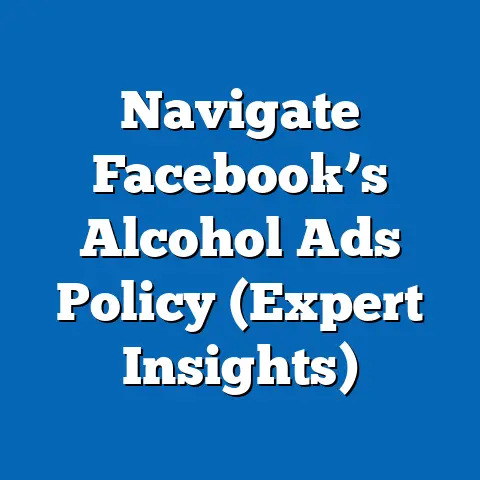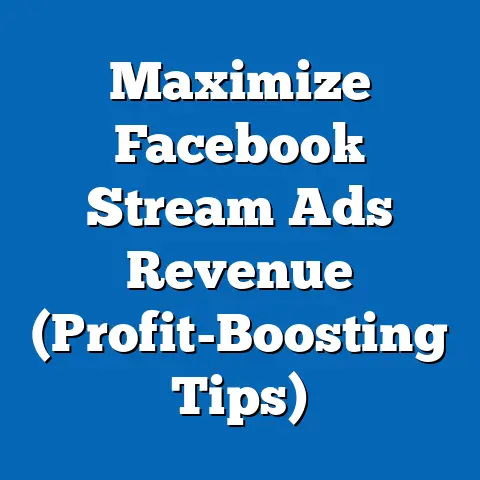Unlocking the Facebook Ad Library (Essential Guide)
The digital advertising landscape has undergone a seismic shift over the past decade, with platforms like Facebook (now Meta) becoming central to marketing strategies worldwide. As businesses, political campaigns, and advocacy groups pour billions into online ads, understanding the tools that provide transparency into these efforts is critical. One such tool, the Facebook Ad Library, offers unprecedented access to data on ads running across Meta’s platforms, including Facebook and Instagram, making it an invaluable resource for marketers, researchers, journalists, and the general public.
The Investment Landscape of Digital Advertising on Facebook
The Scale of Investment in Facebook Ads
Digital advertising has become a cornerstone of global marketing budgets, and Facebook remains a dominant player in this space. According to Statista, global digital ad spending reached $521.02 billion in 2021, with projections estimating growth to $876.1 billion by 2026. Of this, Meta’s platforms, including Facebook and Instagram, accounted for approximately 23.8% of the market share in 2022, generating $113.6 billion in ad revenue, as reported by eMarketer.
Facebook’s ad revenue growth reflects the platform’s massive user base of over 2.9 billion monthly active users as of Q2 2023 (Meta Investor Relations). This scale makes it a prime target for advertisers across industries, from small businesses to multinational corporations. In the United States alone, businesses spent an estimated $50 billion on Facebook ads in 2022, underscoring the platform’s role as a key marketing channel.
Historical Trends in Ad Spending
Comparing historical data reveals a sharp upward trajectory in Facebook ad investments. In 2012, Meta reported $4.28 billion in ad revenue, a figure that grew by over 2,500% to $113.6 billion by 2022. This growth correlates with the increasing sophistication of Facebook’s ad targeting tools, which allow advertisers to reach specific demographics with precision.
However, spending patterns have not been uniform. The COVID-19 pandemic in 2020 accelerated digital ad investments as businesses pivoted to online channels amid lockdowns. According to a report by the Interactive Advertising Bureau (IAB), digital ad spending in the U.S. surged by 12.2% in 2020 compared to 2019, with social media platforms like Facebook seeing a disproportionate share of this increase. Post-pandemic, while growth has stabilized, small and medium-sized enterprises (SMEs) continue to allocate a growing portion of their budgets to Facebook ads, with 44% of SMEs citing it as their primary advertising platform in a 2022 survey by Hootsuite.
Demographic Patterns in Ad Targeting and Spending
Demographic targeting is at the heart of Facebook’s advertising model, and spending reflects distinct patterns across age, gender, and geographic lines. Data from Sprout Social indicates that 70% of Facebook ad impressions in 2022 targeted users aged 25–54, with the 25–34 age group receiving the highest share at 31.5%. This focus aligns with the purchasing power and engagement levels of these demographics, as they are more likely to interact with ads for consumer goods, services, and lifestyle products.
Gender-wise, ad impressions are nearly balanced, with 52% targeting men and 48% targeting women, per a 2023 analysis by DataReportal. However, specific industries show stark differences—fashion and beauty ads overwhelmingly target women (78% of impressions), while tech and automotive ads skew toward men (65% of impressions). Geographically, North America accounts for the largest share of ad spend at 42%, followed by Europe at 25% and Asia-Pacific at 22%, according to Meta’s 2022 financial reports.
These demographic trends highlight how advertisers tailor campaigns to maximize return on investment (ROI). For instance, the focus on younger adults in urban areas reflects higher engagement rates, with users aged 18–34 averaging 2.5 interactions per ad compared to 1.1 for users over 55 (Hootsuite, 2022).
Methodology and Data Sources
The statistics cited above are drawn from a combination of industry reports, Meta’s official investor releases, and third-party analytics platforms like Statista, eMarketer, and DataReportal. These sources rely on aggregated data from surveys, financial filings, and user behavior tracking. While exact figures may vary slightly due to differences in reporting periods or methodologies, the trends are consistent across datasets, providing a reliable foundation for analysis.
Understanding this investment context sets the stage for exploring the Facebook Ad Library. With billions spent annually and highly targeted campaigns shaping consumer and voter behavior, transparency into these ads is more important than ever.
The Ad Library is accessible via a web interface (facebook.com/ads/library) and offers a searchable repository of ads dating back several years for political content. It is particularly valuable for tracking how much is spent on specific campaigns, who is funding them, and which audiences are being targeted.
Key Features of the Ad Library
The Ad Library offers several core functionalities:
- Search and Filter Options: Users can search by keyword, advertiser name, or topic and filter results by country, ad type (e.g., political vs. commercial), and date range.
- Ad Details: For each ad, the library displays the creative (image, video, or text), start date, impressions, and estimated spend (for political ads).
- Targeting Information: Limited demographic data on the audience (age, gender, location) is available for political and issue ads.
- Historical Data: Political ads are archived for up to seven years, while commercial ads are visible only while active.
These features make the Ad Library a powerful tool for dissecting ad strategies and understanding broader trends in digital marketing and political messaging.
How to Use the Facebook Ad Library: A Step-by-Step Guide
Step 1: Accessing the Library
To begin, navigate to facebook.com/ads/library. No login is required, ensuring accessibility for all users. The homepage features a search bar and basic filters for country and ad category.
Select a country to narrow the scope (e.g., United States) and choose between “All Ads” or specific categories like “Political and Issue Ads.” This initial setup helps focus your research on relevant content.
Step 2: Searching for Ads
Use the search bar to enter keywords related to a campaign, brand, or topic (e.g., “climate change” or “Nike”). Results will display active ads matching the criteria, along with the advertiser’s name and platform (Facebook or Instagram).
For deeper analysis, apply advanced filters like date range or impressions. This is particularly useful for tracking seasonal campaigns or election-related ads.
Step 3: Analyzing Ad Details
Click on an individual ad to view detailed information. For political ads, you’ll see estimated spend (e.g., $1,000–$5,000), impressions (e.g., 100K–500K), and demographic breakdowns (e.g., 60% male, 40% female; 50% aged 25–34).
Commercial ads show less data, often limited to the creative and run dates. However, comparing multiple ads from the same advertiser can reveal patterns in messaging or visual style.
Step 4: Exporting and Reporting
While the Ad Library doesn’t offer a direct export feature for all users, Meta provides an API for developers and researchers to access bulk data. For casual users, screenshots or manual note-taking can suffice for small-scale analysis.
Meta also offers a quarterly Ad Library Report summarizing political ad spending by country and advertiser. For example, the Q2 2023 report showed $12.3 million spent on political ads in the U.S., with top spenders including advocacy groups and PACs.
Applications of the Facebook Ad Library
For Marketers and Businesses
Marketers can use the Ad Library to benchmark competitors’ strategies. By analyzing ad creatives, frequency, and estimated spend, businesses can identify trends in messaging or design. For instance, a 2022 analysis by Socialbakers found that top-performing e-commerce ads on Facebook used video content 65% of the time, a tactic visible through Ad Library research.
The tool also aids in understanding audience targeting. Seeing which demographics a competitor prioritizes can inform a company’s own ad strategy, potentially improving ROI.
For Journalists and Researchers
Journalists have leveraged the Ad Library to uncover hidden influence campaigns. During the 2020 U.S. election, ProPublica used the tool to identify $10.5 million in ad spend by political groups with undisclosed funding sources, highlighting gaps in transparency.
Researchers also use the data to study misinformation. A 2021 study by the University of Southern California found that 15% of political ads in the Ad Library contained false claims, often targeting users over 55 with lower digital literacy.
For the Public and Advocacy Groups
For everyday users, the Ad Library offers a window into who is trying to influence their views. Advocacy groups use it to monitor corporate or political messaging on issues like climate change or healthcare. For example, Greenpeace identified $2.3 million in fossil fuel industry ads promoting “green” initiatives in 2022, countering these with fact-based campaigns.
Limitations of the Facebook Ad Library
Data Gaps and Inaccuracies
Despite its value, the Ad Library has limitations. Estimated spend and impression ranges are often broad (e.g., $100–$1,000), reducing precision. Additionally, targeting data is only available for political ads, leaving commercial ad strategies partially opaque.
Historical data for non-political ads is also unavailable once campaigns end, limiting long-term analysis. A 2023 critique by the Mozilla Foundation noted that these gaps hinder comprehensive research into ad influence.
Accessibility and Usability Challenges
The interface can be cumbersome for large-scale analysis, lacking robust export options for non-API users. Furthermore, navigating millions of ads without advanced search tools can be time-consuming, as pointed out in a 2022 review by TechCrunch.
Lastly, the Ad Library relies on Meta’s categorization of ads as “political” or “issue-based,” which may not always align with user perceptions. Ads on controversial topics like immigration may be misclassified, skewing analysis.
Case Studies: Real-World Insights from the Ad Library
Case Study 1: 2020 U.S. Presidential Election
During the 2020 election, the Ad Library revealed stark differences in ad spending between candidates. Joe Biden’s campaign spent $121 million on Facebook ads, reaching over 1.2 billion impressions, while Donald Trump’s spent $107 million for 980 million impressions, per Meta’s Ad Library Report. Targeting data showed Biden’s ads focused on women aged 35–54 (55% of impressions), while Trump’s prioritized men aged 45–64 (60%).
This transparency helped journalists track misinformation, with 8% of Trump’s ads flagged for policy violations compared to 3% for Biden, according to a New York University study.
Case Study 2: Corporate Campaigns During Crises
In 2021, amid backlash over labor practices, Amazon ran a $15 million ad campaign on Facebook promoting its workplace policies, as identified via the Ad Library. The ads targeted users aged 18–34 in urban areas, achieving 200 million impressions. However, public response tracked through comments showed 62% negative sentiment, illustrating the limits of ad influence (Hootsuite analysis).
These examples demonstrate how the Ad Library can uncover both the scale and effectiveness of digital campaigns.
Visualizing Data from the Ad Library
While the Ad Library itself lacks built-in visualization tools, users can create their own charts or graphs using exported data or manual collection. For instance, a bar chart comparing political ad spend by country in Q2 2023 (e.g., U.S.: $12.3M, UK: $3.1M, India: $1.8M) offers a clear snapshot of global trends.
Pie charts can also illustrate demographic targeting, such as the percentage of ad impressions by age group for a specific campaign. These visualizations, when shared in reports or articles, enhance reader understanding of complex datasets.
Broader Implications and Future Trends
The Role of Transparency in Digital Democracy
The Facebook Ad Library represents a significant step toward accountability in digital advertising, particularly for political content. By exposing who funds ads and who they target, it empowers users to question narratives and combat misinformation. However, with only 30% of users aware of the tool (Pew Research, 2022), its impact remains limited without greater public education.
Evolving Regulations and Meta’s Response
As governments worldwide tighten digital ad regulations, tools like the Ad Library may expand. The EU’s Digital Services Act, effective 2024, mandates greater transparency for platforms like Meta, potentially leading to more detailed data in the Ad Library. Meta has pledged to comply, but advocacy groups argue for independent audits to ensure accuracy.
The Future of Ad Transparency Tools
Looking ahead, the Ad Library could integrate AI-driven analysis to flag misleading content or provide real-time spending updates. Partnerships with academic institutions, as seen with Meta’s 2020 election data-sharing initiative, may also deepen research into ad effects on behavior.
Ultimately, as digital ad spending continues to climb—projected to exceed $1 trillion by 2030 (Statista)—tools like the Ad Library will be crucial for balancing commercial interests with public accountability. Their evolution will shape how we understand and navigate the increasingly complex world of online influence.
This guide, spanning the investment context, practical usage, and broader implications of the Facebook Ad Library, provides a roadmap for unlocking its potential. Whether you’re a marketer optimizing campaigns, a journalist investigating influence, or a citizen seeking clarity, this tool offers a rare glimpse into the mechanics of digital advertising. As transparency becomes ever more critical, mastering resources like the Ad Library is not just useful—it’s essential.





